We’ve all tremulously uttered (or heard) the phrase “is Happy Hour…over?” But before you put in that last-minute drink order, ever stop to wonder when Happy Hour actually began?
OK, put in your drink order, because we did the wondering for you. And it’s as scrambled an origin story as Happy Hour deserves, considering the term is now synonymous with frenzied discount drinking and making regrettable karaoke choices in a suit and tie.
And just like how you ended up spending $60 on $5 Margaritas in two hours, the origins of Happy Hour aren’t entirely clear. As a phrase, “happy hour” is nothing new. In The Merchant of Venice, Lorenzo says to Portia “Fair thoughts and happy hours attend on you.” He wasn’t wishing her $4 pitchers, but the basic concept of spending a “happy hour” is about as old as a good mood and spare time.
Happy Hour got its first associations with grown-up socializing in the Navy. There’s evidence of an official “Happy Hour” as early as 1914 on the U.S.S. Arkansas, with a group of “home makers” coordinating said hours called the “Happy Hour Social.” Even though they were sometimes called “Smokers,” these happy hours were a bit more innocent than our modern day variant, involving picture shows and boxing matches. And while we wonder who won the first bout April 17th ( Stickney vs. Dalton) or whether “Army Target Practice” was any good, fair to say it’s all a far cry from Daiquiris and half-priced apps).

Not that booze didn’t accompany these happy hours (the Navy even used to allow the organization of “wine messes”) but that didn’t last. By June of 1914, the Navy issued General Order 99, stating “the use or introduction for drinking purposes of alcoholic liquors on board any naval vessel, or within any navy yard or station, is strictly prohibited.” Naval Happy Hours continued, of course. They just got less happy.
So how did “Happy Hour” make the leap from aquatic fisticuffs among seafaring American strongmen to landlocked office gossip over pitchers of Miller and dollar wings? Prohibition. When The Volstead Act was passed, everyone stopped drinking for 13 years. Just kidding, we actually drank a ton, just secretly, often in “speakeasies.” One problem: if we wanted to go out to dinner, which fancy men and ladies were wont to do back in the day, we could no longer anticipate the pleasures of drinking and dining. So, like kids before Prom, Prohibition-era Americans drank together secretly before going out formally, in a kind of “happy hour” fest of rapid intoxication and, possibly, taffeta.
Still, these weren’t designated “happy hours.” But the tradition of drinking collectively, and with certain, er, aggressive purpose before dinnertime had certainly coalesced into something habitual. The term “happy hour” stumbled into its unofficial ‘discount drinks’ meaning somewhere in the late ‘40s or early ‘50s, no doubt owing to some post WWII-revelry and the “normalization” of work-home life for newly re-settled Americans. As Art Ryon wrote in The Los Angeles Times in 1951, “If you think people have lost their price consciousness, you ought to see the stampede at a Valley tavern during its ‘Happy Hour’ from 5 to 6 p.m.’” And then, less than a decade later we have Harold Martin at The Saturday Evening Post, writing about employees at Cape Canaveral’s Patrick Air Force Base in 1959. “[T]hey came seeking a place where a man, without neglecting his job, can still find time to fish and swim,” waxes Martin. “Except for those who spend too much during ‘happy hour’ at the bar—and there are a few of those.” On the cusp of the 1960s, Happy Hour had decidedly lost its proud Naval luster.
But before we delve any further into the American origins of Happy Hour, we should mention an argument for French origins. In Alcohol: A History, Rod Phillips notes the rise of a kind of happy hour in Paris in the late 19th Century. A wine shortage had people, mostly the aristocracy, turning to spirits for their daily intoxicants, most notably absinthe. “It became popular in the bistros and bars of Paris in the 1860s and 1870s, when five o’clock in the afternoon, the time after work when people drank absinthe, became known as ‘l’heure verte,’ or the green hour.” Again, even this version of “happy hour” doesn’t incorporate the idea of the heavy discounts which, if we’re being honest, is one of the only reasons many of us endure the larger crowds and maybe lesser drinks of happy hour itself. But the idea of social, collective drinking before dinner—albeit across the pond—was there.
Fast forward to the States about a hundred years and by the ‘70s and ‘80s, however it came, “Happy Hour” meant drink specials, and bars and restaurants everywhere were wisely taking advantage of it. The exact economics of happy hour escape us a bit, but the basic idea is the increased demand offsets the decrease in cost (for further reference, and many confusing charts, refer here). Not to mention, if you dive into the deep end of any bar’s Happy Hour, there’s a chance you’ll be staying well past the discount hours.
Depending on where you live, of course. Since the 1980s, when Massachusetts became the first state to ban happy hour (yes, it sort of seems like banning alcoholic Christmas), there’s been some momentum of backlash (11 states have followed with full bans). Other states attempt to regulate happy hour (e.g. banning “unlimited drinks” or the length of happy hour itself). And some states (18, plus D.C.) don’t ban or attempt to regulate at all. Depending on your particular feelings on the modern Happy Hour (e.g. whether you actually leave feeling happy), you’ll want to decamp to your state of choice sometime soon. Happy Hour may not last much longer.
